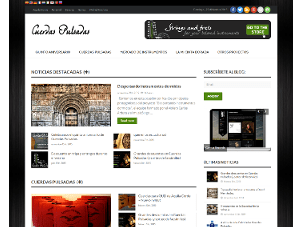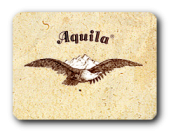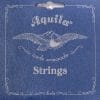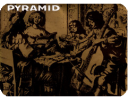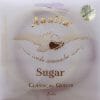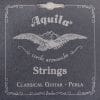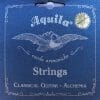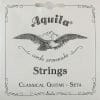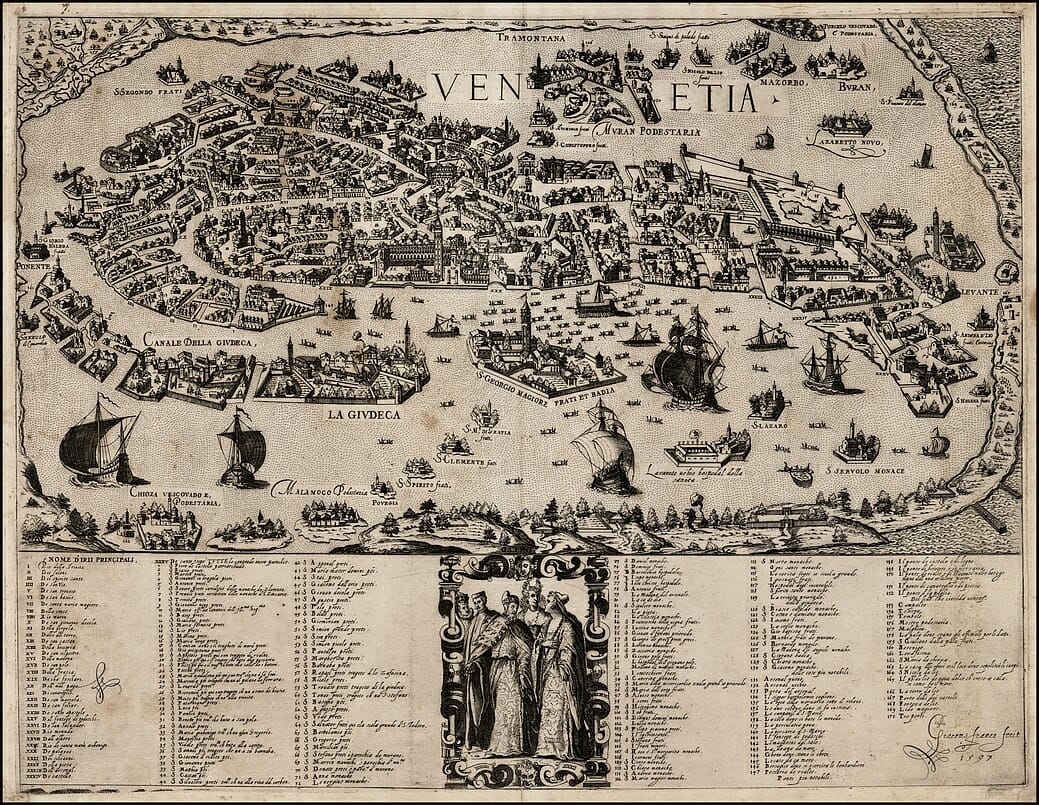Gerolamo Gallo, musico della Cappella Ducale di Genova
Luciano Borzone (Genova, 1590 – Genova, 1645) (source)
Some time ago I rediscovered the excellent research work made by Anne Marie Dragosits about one of the most famous lutenists and theorbo composers of all times, Giovanni Girolamo Kapsperger.
The thesis is extremely interesting not only because of the musician itself (always original and genuine) but also because of the author’s point of view, being Anne Marie mainly a hapsichord player.
The thesis aims to change the perception of Kapsperger (ca.1580-1651) via three different angles: A reconstruction of his life and career with a substantial amount of new biographical information builds one pillar of the book, whereas in the second part his vocal works are approached and contextualized as prototypes of radical “stile novo” in Roman characteristic. The last third is dedicated to questions about basso continuo and Roman performance practice in Kapsperger’s lifetime, dealing also with the composers’ own material on continuo as fount of inspiration for continuo players of all instruments.
Kapsperger is mainly known for his works for theorbo and lute, but his remarkable output of vocal music of all genres is also delightful, although is still mostly neglected from musicologists and performers.
Anne Marie’s research is an excellent source to learn about Kapsperger’s life: his roots, family, friends, influencers, work… and also to understand the reasons behind his bad reputation among some circles.
So, I sent an email to Anne Marie to congratulate her about the thesis and to let her know that it will be a pleasure to have an interview. She kindly accept the offer and spent a generous amount of time answering all the questions, and I am very grateful for that.
I am also proud to announce that soon we will enjoy the next Anne Marie’s work: a book entirely devoted to Kapsberger.
Enjoy the interview!
Anne Marie, you are a harpsichord player so, what is your relationship with plucked string instruments?
I very often get the question how and why I, being a harpsichord player, developed such an interest in a theorbo-player and theorbo-composer such as Kapsperger.
I always loved his strong, emotional and highly original theorbo pieces, and only because of them did I get to know him. But my main interest lies in his vocal music. It’s a big field to explore, as he was such a prolific composer for all genres of vocal music. As a continuo player, there are loads of music I can play on harpsichord or organ and thereby experience his music myself. “Translating” his theorbo or lute pieces for keyboard does not work very well though, with exceptions like the famous “Arpeggiata” with its ingenious succession of chords.
Intavolatura della prima toccata dal libro primo d’intavolatura di chitarone Kapsberger, published in Venezia 1604 (source)
I very often play in ensembles with mixed continuo and always enjoy the sound of plucking and the communication with plucked instruments – in my opinion the harpsichord is as well a plucked instrument, even if we pluck more indirectly, with the help of key, jack and quill – but the more we feel ourselves “plucking”, the better we can play together with the real pluckers…
What are the reasons why you choose choose Kapsperger for your PhD?
I had already started working on Kapsperger for my masters’ thesis, I made an edition of his “Cantiones sacrae”, a book with short sacred pieces for 1-5 voices with continuo, music of a high quality in my opinion. When I wanted to add a short biography as an introduction, I was surprised how little information there was on his life.
Besides the work of Paul Kast, who did some early research in Rome and unearthed the first biographical documents there, and Victor Coelho, who’s excellent article (G.G. Kapsberger in Rome, 1604-1645: New Biographical Data, in: Journal of the Lute Society of America 16 (1983), p.103f.) forms the fundament of my research, musicology seems to have little or no interest in the composer.
With a short-time-scholarship from the Music University in Vienna (mdw), I went to Rome for not more than two weeks and, again to my big surprise, very quickly found some new biographical information. Lacking time and money I kept the idea of doing more research somewhere in the back of my head, and when the opportunity for the PhD arose, I took the chance to dig much deeper.
At that time I was studying the harpsichord with Ton Koopman in The Hague and had been asked to write the article on Kapsperger for the MGG, for this I was also using Mr. Koopman’s amazing private library. While I was working on this article, he told me about the then very fresh and new doctoral program for artistic PhDs, docARTES, a collaboration between Dutch and Belgian Insitution, where I then was accepted with my project on Kapsperger.
Your work tries to change the current perception of the composer by researching more information on three aspects of his work and life. Which one was the most difficult to do the research?
The doctoral thesis had three main branches, to be honest actually too many…
On one hand I tried to do a lot of research about Kapsperger’s life, his surroundings and his contacts, trying not only to find more biographical facts, but also trying to understand how his contemporaries thought about him. For the research I spent a lot of time in Italian Archives, mainly in Rome and Venice, but also in Florence and Naples, looking for new original information.
On the other hand I tried to get an overview about the vast amount of vocal music he composed in so many different genres and styles or fashions. This included a lot of time behind the keyboard, trying to play and perform as much of his music as possible, also testing the reactions of my musician colleagues and the audience. Here I worked very much with my ensemble “vivante” (www.vivante.at): two tenors and a broad array of continuo instruments of all sorts. In the very beginning of these years we recorded a part of Kapsperger’s “Libro sesto di Villanelle, li fiori” (label ORF Edition Alte Musik), soli and duos on texts by Francesco Buti.
For bigger pieces like Madrigals and Masses or for the Christmas history “I pastori di Bettelemme“ we’ve invited other singers and instrumentalists.
Last but definitely not least I tried to collect as much information on the field of performance practice which tell us more on the early Italian basso continuo style, including information by Kapsperger himself, like his realizations for theorbo in some books of vocal music, and his exercises for theorbo for improvising on bass notes. For this part of the thesis I transcribed Kapsperger’s continuo material from the theorbo tablature.
I found all three branches very interesting and at the same time very challenging. Not really being trained as a musicologist, the archival work was a real challenge for me, but on the other hand I found it extremely interesting. Seeing so much original documents gave me a much clearer idea of the epoch in itself, of what it meant to live then, in whatever context – be it culture, music, arts or the social system, social standings, finances, or even food and drink…
Fine dark impression of the first edition of Giacomo Franco’s fine view of Venice, probably based on a map by Paolo Forlani.
The first edition of the map was published in 1597 (source)
The practical work on the music was very enjoyable, as we unearthed so much good music, my colleagues as well as the audiences appreciated the pieces as much as I did, which was a big encouragement while I was spending so much time with this composer. By also playing the pieces and not just looking at them and analyzing them, the strong emotional content of Kapsperger’s vocal music, be it about secular or sacred love, became very obvious to me.
In trying to understand the style of this time, I also started to discern the differences between composers in the Early Italian style, and started to perceive a very special and very Roman version of the “stile nuovo”, which differs a lot from music in other cities like Florence, Naples or Venice, just to name three of them. Some features of Kapsperger’s vocal music are much easier to understand putting him in context, also in questions of performance practice, of this particular Roman style, which musicology until only some years ago called inferior to the famous Florentine monody…
The most difficult part for me were the chapters on performance practice, which I myself did not plan to write, but had to include because of the rules of the doctoral program. In my opinion all these single issues would deserve considerably more space. With the time I had, I could not do more than scratch the surface on all these complex questions.
But I was also fascinated to see how many unanswered or only partly answered questions there still are, and how much need for much more research there still is in this field. How difficult or in fact kind of impossible it is to be 100% sure of anything.
My own ideas on basso continuo playing are constantly on the move, by always playing and reading and trying to get deeper into each style. I love this art, which involves brain, fingers, ears, clear ideas and free communication, rules and flexibility at the same time, and I am confident I will keep getting new ideas, information and inspiration throughout my life.
In your opinion, Anne Marie, what are the most surprising facts about the life of the composer?
I of course started with reading everything which had been written about Kapsperger, whom I had regarded as a slightly crazy, but particularly interesting composer. I was shocked by the negativity of most of the comments on him in dictionaries, articles and books. But while questioning his perception throughout music history, I quickly realized I was witness to a rare case of reputational damage, due to a single negative voice, one malevolent anecdote of dubious truth by the theorist Giovanni Battista.
Exceptionally offensive judgement by music theorists from the 19th and 20th century, who copy and enrich Doni’s tale without verification, stands diametrically opposed to a very positive picture of the composer during his life: Athanasius Kircher in 1650 even puts Kapsperger on one level with Monteverdi in his “Musurgia universalis”, numerous other 17th-century witnesses confirm Kapsperger’s standing as one of the main Roman representatives of the stile nuovo.
The 19th century mainly perceived Kapsperger as an enemy of Palestrina, Doni’s tale being more and more embroidered. From a certain point on Kapsperger was denied every talent and even being of noble birth, Ambros calls him a “boastful charlatan” in 1909. In the 20th century Kapsperger was also employed as a scapegoat by defenders of the supremacy of Florentine monody against the more virtuosistic Roman stile nuovo-variant: Nigel Fortune still in 1953 calls Kapsperger an “inferior craftsman” and his works “inept trifles, just like all the other airs composed in Rome – bungling and unmelodius”.
Only in the last few decades has his music begun to be reassessed. But while his pieces for lute instruments by now form a crucial part of their repertory, the rediscovery of his vocal music proceeds much more slowly – for too long had the image of the brilliant theorbist but “bad” composer prevailed.
New research during the last years – and not just by me! – has uncovered lots of new biographical information: the portrait of a exceptionally creative and radically modern composer, envied and admired by his contemporaries, emerges.
One of the surprising biographical facts is that he lived in Naples at least in 1604, while his first book for the theorbo was published. Most probably he stayed there for some years and might have married his Neapolitan wife there, Girolama de Rossi, who was like Kapsperger himself of noble birth. In January 1604 their daughter Dorotea, who died only four years later in Rome, was born.
Libro primo d’involatura di chitarrone – Venetia 1604
This new document, only recently discovered by Luigi Sisto, helps us to finally understand the origin of the obvious Neapolitan elements in Kapsperger’s style, for example his special affinity to the Villanella and to the baroque guitar, whose rise to become the favorite instrument of the nobility around 1600 originated from Naples.
The “Libro primo di Villanelle” (Rome, 1610) is the very first vocal print introducing the alfabeto, a tablature for the baroque guitar, in addition to the basso continuo line. Kapsperger’s example was followed immediately, prints with alfabeto became very fashionable during the next decades. Kapsperger himself composed Villanelle all over his life, between 1610 and 1640 seven books were printed, the last of which presents us with his swan song, a collection of Villanelle on sacred and moralistic poems.
I also was surprised to discover how much he must have felt the conflict between his noble birth and his position as a musician during all the variuos stages of his career, even if famous and obviously rich.
The “nobile Alemanno” had all his secular prints published by supporters and friends, who added flattering dedications and poems. He himself dedicated works exclusively for the Barberini, the family of his biggest supporter pope Urbano VIII.Barberini, this family being of such high social standing at that time, that dedicating works to them would not affect his own standing in a negative way…
Kapsperger seems to have played a strange double role in the Roman cultural elite. In the circles of Accademici and “virtuosi of taste” (thanks to Andrew dell’Antonio) educated conversation about art had become more important than the artifact or the artist. Kapsperger did not only hold his own Accademia, but was a member of several prominent Accademies, most notably of the famous Accademia degli Umoristi.
That the musician Kapsperger as a nobleman of manifold interests gained entrance into that elite himself, makes him a kind of double “virtuoso”. Thus he had maneuvered himself into an impossible balancing act between two functions, which exclude each other. The description of a private concert for Cardinale Bevilacqua and his guests in 1611 shows the incompatibility of Kapsperger’s parallel lives: “…e poi sono stati a pranzo dal S.r Card.le Bevilaqua; e per lor trattenimento ha fatto sonare il Todesco dalla Teorba, al quale ha dato tanti titoli che se n’è ritornato a casa gonfio: altramente non aveva cenato, pretendendo di essere gentiluomo e di non voler cenare se non con gentiluomini e accademici” (Dinko Fabris, Mecenati e musici: documenti sul patronato artistico dei Bentivoglio di Ferrara nell’epoca di Monteverdi (1585-1645), Lucca 1999, p.228;” first quoted and translated by Victor Coelho: “…and then they were lunching at Cardinale Bevilaqua’s; and for their treatment he had the Todesco dalla Teorba play for them, to whom he gave so many titles that he went home swollen: in addition he had not eaten, pretending to be a nobleman and not to wanting to eat if not with gentlemen and nobles”
The author of this rather insulting description, Vincenzo Landinelli, by the way shortly afterwards must have befriended the man he criticized – he was the godfather of one of Kapsperger’s daughters in 1613.
Even though Kapsperger’s class consciousness clearly did not make him good friends with his fellow musicians, as for example the ironic poem by the theorbist Bellerofonte Castaldi on Kapsperger shows, it could not blemish his reputation as a musician. Numerous founts call him the best theorbist in Rome, usually in the same breath with Frescobaldi as the most brilliant keyboard player. He also was a famous teacher and charged two times more for lessons than his colleagues.
Figure for the Chitarrone article in A Dictionary of Music and Musicians (1450-1889) (source)
If one “only” knows his pieces for theorbo and lute and some of his Villanelle, which with their simple melodies, perfectly depicting the melody of the poetry, do have pop-song-quality, a closer look on all the other vocal music offers more surprises. In his first years in Rome he composed a book a Madrigals for 5 voices with b.c., full of madrigalisms, chromaticisms and bold harmony changes. The following years brought books of “arie” and “motetti passeggiati”, with extremely challenging ornaments and runs for the singers – typical “Roman” style of this period.
In Barberini-Rome Kapsperger turned towards sacred music, covering a wide spectrum of genres: He composed odes in simple and clear recitative style as well as strongly emotional and highly virtuosistic monodies, again dancelike or lyrical Villanelle on moralistic poems as well as pieces for several voices like his 4-, 5- or 8-part masses – symptomatically published as “Missae Urbanae”.
Some short excerpts from a concert we did with my group „vivante“ prior to the final concerts for the PhD show the different styles of his sacred vocal music:
At least twice the Capella sistina sang masses by Kapsperger, once because Urbano had asked to hear it. Kapsperger alludes to this situation in the dedication of the Missae Urbanae (1631) to Urbano: “Opus cui olim annuisti, recognosce…” (“Recognize the work, which you once nodded at…”).
Doni’s attack on Kapsperger is situated in this environment, he narrates how Kapsperger disastrously failed in replacing Palestrina’s works in the repertory of the Sistina with his own pieces – because the singers rejected to sing his dreadful “Modulationes”. In the usually very precise documentation of the Sistina, however, no hint of this episode has been found until this day. On the contrary, the diarist describes how Kapsperger climbed the balcony after one of the performances to thank the singers personally. Enough proof of other scandals though can be found in those documents, for example when Stefano Landi, composer and a member of the Sistina himself, in 1631 tried to supplant Palestrina’s responsories for Holy Thursday.
Same crime, same time, different actor – did Doni wrongly attribute the scandal about Landi to Kapsperger?
After all his achievements Kapsperger suffers a sudden setback around 1633: Was he simply getting out of fashion and were younger colleagues taking over? Does Doni’s story contain a grain of truth? Or was he a victim of the upheaval at the papal court after Galileo Galilei was processed and forced to withdraw?
There is quite some evidence for the third hypothesis. Kapsperger had been too close, not only to the Accademia dei Lincei, which was liquidated after Galileo’s process, but also to many libertine intellectuals. He would have been too close, in particular, to Giovanni Ciampoli.
This Florentine had long been one of Urbano’s favorites – the deeper was his downfall, during the intrigues surrounding Galileo’s process Urbano felt betrayed by Ciampoli and hence banned him from Rome. For years poet and composer had together impersonated success, it seems a logical consequence that Ciampoli’s fall from favor had a strong impact on Kapsperger’s standing at the papal court.
A cloud of silence muffles his further career, shortly after Galileo’s trial he lost all his lucrative and prestigious assignments. He still stayed a member of Cardinale Francesco Barberini’s “famiglia” as a musician, but his monthly wage there was peanuts compared to what he had earned before.
The breakline is also obvious in view of his publications: After a flood tide of prints around 1630 there is a conspicuous gap until 1640, when his two last prints appear – again edited by supporters like in his earlier years.
After 1633 the family started to climb down the social ladder, in 1651 Kapsperger died impoverished. His widow and two daughters outlived him, but after 1652 their traces are lost.
The Kapsperger works are know to be kind of exotic, is this a common feature in his entire work (vocal music, f.e)?
Kapsperger aimed to present himself as a modern composer from the very start, very often his prints are “first” in something, starting with his first theorbo book, which is indeed the first print for solo theorbo. His first book of Villanelle (1610) is, as mentioned above, the first print including the alfabeto for the baroque guitar. His madrigals are the first ones with continuo printed in Rome, and so on…
Some of the more radical features he introduced in the end proved to be a blind alley, music did become a bit more conservative again after the big upheaval of the change from stile antico to stile nuovo. And some features which were then kind of a shock to the audience, were quickly outlived, like the homophonic choir sections in his bigger pieces. As witnessed by contemporaries, these left the audience very impressed, as they heard many people singing as if with one voice, letting the poetry and its meter prevail.
G.G.Kapsperger, Ego dormio, „Libro primo di mottetti passeggiati”
In his vocal music, Kapsperger generally treats poetry with obvious respect, with great care translating not only rhythm and melody but also the emotional impact of the spoken word into music. Sometimes the musical form of his compositions gives the impression of a picture puzzle of various and colorful ideas, as if he had been carried away by musicating a poem word by word. In general he appears to follow the credo of the stile nuovo – poetry rules over music – even more than most of his colleagues, making the pieces by that maybe what one could call “exotic”.
What about the instructional side of the author, many pieces from that time include best practices, conventions, advices… what can we learn from his work?
His continuo realizations for theorbo in some of his prints of vocal music are useful particularly for beginners of the rather complex art of playing continuo on the theorbo. While staying quite simple, they show the very usual Italian concept of showing the outline of the complete score in the realization. The tablature often doubles the singing voices with their melodies, but stays on simple chords while the singing voices show off with runs or trills.
A virtuoso player like Kapsperger will have added lots of colours and special features to his own continuo playing, probably following Agazzari’s description of the contemporary practice by distinguishing between representing the function of a fundamento or ornamento instrument.
That Kapsperger’s playing must have been very impressive and passionate is prooved by a description by his friend, the poet Ciampoli, when he praises the festivities for the coronation of pope Urbano VIII.:
“Di lunghe fila armata
Tiorba à febo amica
Con Alemanno ardir fulmini, e tuoni.”
“Armed with long strings,
the theorbo, Phoebus’ friend,
with German fire lightning and thunder”
Partly very instructive – and not only for theorbo players – are Kapsperger’s exercises for small variations on bass notes, which he gives at the end of the third theorbo book (which had been lost for many decades, and is now preserved at Yale University).
Ludovico Lana (1597–1646) – Ritratto del liutista Girolamo Valeriani (source)
Some of the examples use idiomatic theorbo techniques, but many others can be used as a source of inspiration for continuo players on all sorts of instruments. These exercises can also guide us with the interpretation of his “Sinfonie”. In this print he only lines out a sketch, like a skeleton of form, melody and rhythm, with very plain lines for the upper voices and just some bass notes for solo sections for the basso continuo, sometimes for up to three continuo instruments.
This again shows a rather radical approach of the composer, leaving complete freedom in ornamentation and invention to his interpreters – and again this is very much “Roman” practice, as other pieces of this time show. A musicologist of the 19th or early 20th century not skilled in the art of continuo, and not realizing just how many more notes he would have heard than he could see in the print, could only consider these pieces a kind of “joke” from a very bad or at least very lazy composer…
What are your next steps regarding this research?
The research and writing period for the PhD was long and intense, even more as I worked a lot as a harpsichord player at the same time. It was good to free my head for some time afterwards from the thought of further research, also concentrating on my own playing again – for example preparing my new CD “avec discretion” with toccatas and suites by Froberger (coming out this December, with Divox), recorded on a original Girolamo de Zentis from 1658.
By the way, the two Germans must have known each other. When Froberger came to Rome to study with Frescobaldi, Kapsperger was the latter’s direct colleague in the private chapel of Cardinal Francesco Barberini. Froberger’s second trip to Rome led him to look for guidance from another close acquaintance of Kapsperger, Athanasius Kircher, who in exactly those years compiled his “Musurgia universalis”, obviously with help by Kapsperger.
With “vivante” (www.vivante.at) we still do a lot of Kapsperger, always trying new pieces and also starting to perform the bigger works. Last year we all fell in love with “I pastori di Bettelemme”, Kapsperger’s small christmas oratorio, which we performed together with the Marini Consort, we hope to be able to repeat this production soon. Currently we have finally started to work on a program which is going to feature his 5 part-madrigals, extremely interesting stuff in our opinion…
With fresh energy I am now revising the biographical part of the thesis, which is going to be published in German. I am not just correcting mistakes or trying to make the writing better and the story more readable, but also searching to get more and new answers for at least some of the many still open questions on the composer and his music. Some new details have already been unearthed, and I am confident the book will offer more new information on Kapsperger!
Thank you so much for you time Anne Marie, and your valuable information and work about Kapsperger.

